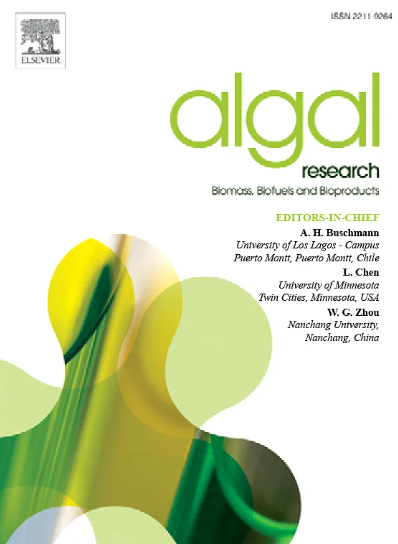Exploring the effect of glycerol and low-cost agricultural fertilizer for enhanced microalgae biomass production and wastewater treatment
IF 4.6
2区 生物学
Q1 BIOTECHNOLOGY & APPLIED MICROBIOLOGY
Algal Research-Biomass Biofuels and Bioproducts
Pub Date : 2025-05-27
DOI:10.1016/j.algal.2025.104117
引用次数: 0
Abstract
Microalgae may prove to be a dependable feedstock to produce value-added bioproducts if their production can be made economically viable and environmentally sustainable. This study evaluated the performance of a locally isolated microalga, Chlorella sp. BRE4 for biomass growth and nutrient removal efficiency in wastewater supplemented with NPK fertilizers and an organic carbon source. The maximum biomass yield was 2.91 g L−1 with urea (0.75 g L−1), 2.95 g L−1 with single super phosphate (SSP) (0.75 g L−1), and 2.83 g L−1 with muriate of potash (MoP) (0.1 g L−1) when each was added separately to the wastewater. In the photobioreactor (PBR), the developed wastewater-based medium was supplemented with glycerol and grown under different trophic modes. The microalga showed a maximum biomass yield of 3.16 g L−1 under mixotrophy with CO2 sparging (PBR4-MC), which was 4.93, 2.53, and 1.03 times higher than heterotrophy with simple air sparging (PBR1-HA), heterotrophy with CO2 sparging (PBR2-HC), and mixotrophy with simple air sparging (PBR3-MA), respectively. Biochemical analysis shows that maximum lipid (106.5 mg L−1 d−1) and carbohydrate (94.8 mg L−1 d−1) productivities were achieved in PBR4-MC, being 2.8 and 7.8 times higher than under heterotrophic conditions. Moreover, the cultivation of Chlorella sp. in glycerol-supplemented low-cost medium (LCM) removed 92.9 % total nitrogen and 94.1 % total phosphate during the microalgal growth period of 10 days. These findings demonstrate the feasibility of integrating low-cost agricultural fertilizer and industrial by-products like glycerol in wastewater to enhance microalgal biomass and lipid production, enabling waste valorization and supporting circular bioeconomy strategies.
探讨甘油和低成本农用肥料对微藻生物量生产和废水处理的影响
如果微藻的生产能够在经济上可行和环境上可持续,那么微藻可能被证明是生产增值生物产品的可靠原料。本研究评估了局部分离微藻小球藻BRE4在添加氮磷钾和有机碳源的废水中的生物量生长和养分去除效率。分别添加尿素(0.75 g L−1)、单一过磷酸钙(0.75 g L−1)和硫酸钾(0.1 g L−1)时,最大生物质产量分别为2.91 g L−1、2.95 g L−1和2.83 g L−1。在光生物反应器(PBR)中,在开发的废水基培养基中添加甘油,并在不同的营养模式下生长。微藻在CO2喷射混合养(PBR4-MC)下的最大生物量产量为3.16 g L−1,分别是单纯空气喷射异养(PBR1-HA)、CO2喷射异养(PBR2-HC)和单纯空气喷射混合养(PBR3-MA)的4.93倍、2.53倍和1.03倍。生化分析表明,PBR4-MC的脂质(106.5 mg L−1 d−1)和碳水化合物(94.8 mg L−1 d−1)产量最高,分别是异养条件下的2.8倍和7.8倍。此外,在低成本培养基(LCM)中添加甘油培养小球藻,在10天的生长过程中,总氮去除率为92.9%,总磷酸盐去除率为94.1%。这些发现表明,将低成本的农业肥料和废水中的工业副产品(如甘油)结合起来,可以提高微藻的生物量和脂质产量,从而实现废物增值,并支持循环生物经济战略。
本文章由计算机程序翻译,如有差异,请以英文原文为准。
求助全文
约1分钟内获得全文
求助全文
来源期刊

Algal Research-Biomass Biofuels and Bioproducts
BIOTECHNOLOGY & APPLIED MICROBIOLOGY-
CiteScore
9.40
自引率
7.80%
发文量
332
期刊介绍:
Algal Research is an international phycology journal covering all areas of emerging technologies in algae biology, biomass production, cultivation, harvesting, extraction, bioproducts, biorefinery, engineering, and econometrics. Algae is defined to include cyanobacteria, microalgae, and protists and symbionts of interest in biotechnology. The journal publishes original research and reviews for the following scope: algal biology, including but not exclusive to: phylogeny, biodiversity, molecular traits, metabolic regulation, and genetic engineering, algal cultivation, e.g. phototrophic systems, heterotrophic systems, and mixotrophic systems, algal harvesting and extraction systems, biotechnology to convert algal biomass and components into biofuels and bioproducts, e.g., nutraceuticals, pharmaceuticals, animal feed, plastics, etc. algal products and their economic assessment
 求助内容:
求助内容: 应助结果提醒方式:
应助结果提醒方式:


